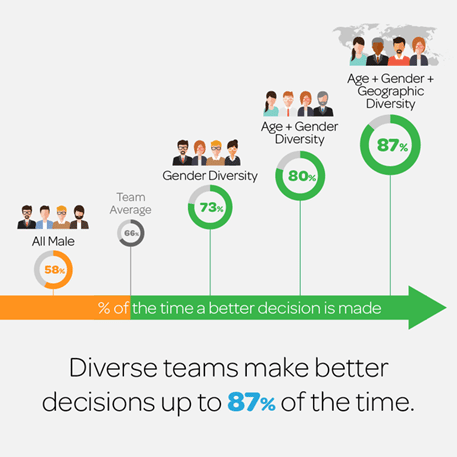How To Ensure Diversity and Inclusion Using Video Interviews

Since video interviews have proven to be necessary for the current business ecosystem, it makes sense that business owners utilize video interviewing software in a manner that doesn’t exclude any group of society. So, in this post, we will examine the steps for ensuring diversity and inclusion during video interviews and how video interviewing bolsters diversity and inclusion initiatives.
Tips for implementing diversity and inclusion during video interviews
-
Utilize a structured interview process
A structured interview process is a bastion that holds off tides of bias and upholds diversity and inclusion during video interviews.
It ensures that decisions are not made based on the flimsy emotions or guts of the interviewers. Therefore, all candidates will be on a level playing field, and there will be better predictability of a candidate’s success on the job upon employment.
Some tips on how to create a structured interview process are:
- Having clear questions for all candidates
- Avoiding embarrassing questions
- Having trained interviewers
-
Keep a diverse team of recruiters
Just as employees like to see diversity in the workforce, so is the case for candidates during the interview process.
While there are multiple benefits of a diverse team of recruiters, the most prominent are:
- It shows candidates that everyone is welcome to join the business, regardless of race, gender, and other factors.
- Secondly, a diverse team will help spot the various strengths and weaknesses of the various candidates.
Consequently, the candidates will be convinced from the get-go that the interview process is not geared against them. Also, there will be much better hiring decisions after a consolidated evaluation of the candidates.
-
Inform your applicants
Communication is crucial to implementing diversity and inclusion in video interviews. Notify the applicants in advance that it will be a video interview. This will enable them to prepare their dress and environment for the interview.
Give them tips on what they can do to ensure that their tech setup is suitable for the video interview. This is much better than simply demanding that they have high-end devices because they might opt out if they feel that their device’s specs don’t measure up. That is antithetic to your diversity and inclusion initiatives.
-
Give your candidates options
Choice is a pillar of inclusion.
There’s no denying that things occasionally go wrong in tech setups.
True inclusion demands that an alternative means of communication, such as a dial-in number be provided in case anything goes wrong.
-
Put yourself in their shoes
The interviewing process might not seem like a walk in the park to some candidates. Thus, it is imperative for interviewers to show empathy during video interviews.
Here are some empathic moves that will help candidates feel comfortable during the video interview:
- In the event of any disruption, assure the candidate that their performance won’t be jeopardized.
- If the Internet bandwidth is a challenge, you can hold the introductions on camera, and suggest turning it off during the formal interview to ensure that questions and answers are heard and recorded clearly. At the end of the interview, turn the camera back on and round up appropriately.
-
Let them be heard
Make it known that the candidates are welcome to ask questions if anything seems amiss. Emphasize the fact that their questions won’t affect their application.
Letting them know that they have a voice spells true inclusion because they will feel welcome in the hiring process.
When you create such a window, expect questions relating to technology and its surrounding challenges, and information on their current circumstances. This will let you or your hiring team adjust accordingly.
How video interviewing improves workplace diversity and inclusion
-
It exposes conscious and unconscious bias
A sure way that video interviews and video interviewing software improve an organization’s diversity and inclusion efforts is by uncovering instances of bias during the interview process.
Since the various interviews are recorded and stored in the software, if you suspect foul play or a deviation from your structured process, you can always refer to the videos. This makes it possible for you to closely observe the assessment of candidates by the various members of your hiring team.
In the event of any complaint of discrimination by candidates, you can easily check out the videos for any telltale signs of bias.
-
It’s convenient for vulnerable candidates
Video interviews also help businesses attain their diversity and inclusion goals because they improve accessibility in the hiring process.
The traditional style of interviews demands that candidates make their way to the business’ location. However, this can prove stressful for vulnerable persons such as candidates who are pregnant, somewhat ill, or otherwise vulnerable.
Making the trip down to the interview location could seem entirely discouraging, and they might end up missing out on the job opportunity. Consequently, the business could also miss out on exceptional minds.
Video interviews ensure that candidates do not feel left out merely because of their circumstances. They can easily complete the interviews from their place of comfort, fully focused on acing the interview.
-
Video interviews erase geographical barriers
The bane of many businesses that are stuck in the old recruitment process is the shallow pool of candidates. Often, only people who live in the area can apply. This is unhealthy for diversity initiatives.
With video interviews, however, organizations can scale geographical confines, and access a global pool of talents.
Did you know that businesses that implement diversity and inclusion make better decisions?
Image Source: Forbes
A structured video interview helps you communicate and connect with candidates from diverse cultures and backgrounds. While they might be miles away, they just might be your best shot!
-
No travel expenses
The traditional methods of interviewing always come with a significant expense if the candidate doesn’t live in the area. The expenses could include transportation (think flights), lodging, and even meals.
Such expenses are discouraging, and can entirely stop a good number of potentials from applying because of tight budgets. However, video interviewing aids your diversity and inclusion initiatives because no candidate will feel left out of the hiring process simply because of their current financial status.
All they need is a simple internet connection, and they’re good to go.
-
Improves collaboration with the recruiting team
Video interviewing software makes it possible for video interviews to be recorded.
This feature of recording video interviews supports diversity and inclusion because the clips can be easily shared and viewed by various members of the hiring team.
Watching the recordings with multiple members of your team can yield a consolidated evaluation that helps whittle down bias and discrimination in the processes of recruitment and hiring.
In closing, if your business utilizes video interviews, be sure to enforce these steps to keep your diversity and inclusion efforts during video interviews booming. If you are, however, yet to jump on the video interviewing bandwagon, then waste no more time. Our Shine video interviewing software has all you need.

